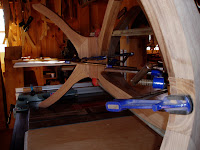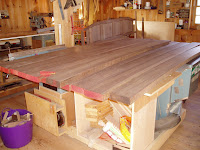Pedestal Table Part III
This is the stage where we start assembling the arch and shaping the legs.


Once all the arch pieces are cut I like to lay them out, and then trace the pattern on the pieces. Then I can layout where the mortises will be cut without interfering with the layout.
The mortises were cut in the same manner as used with the legs, however here on the arch I varied the width to stay within the pattern.


The glue up for the arch is slightly different than with the legs. First since the arch will be a closed loop, I rough cut to the inside pattern lines before gluing. I glued the top three pieces in the same manner as the legs using the bench vice and clamps. Then I glued and pieced together the whole arch as shown at right.
With the glue applied then I just used clamps and equal pressure to get the arch square and let the glue cure.

Even with glue and tenons, I like to reinforce the joint with pegs.


Depending on the design and the wood, I'll either use a matching peg or a contrasting wood for the peg. To maintain a strong joint I do not drill and peg completely thru the material, just thru the loose tenon material.
The next step in the process is to rough cut the pieces. I like to do a quick sanding of the pieces then retrace the template outline in case some of the pieces have shifted during clamping and
gluing.


I rough cut using the
bandsaw, I'm not trying to be precise at this point, since I'll be using the router to clean up all the waste.

Using a top bearing flush trim bit and the template, its a very straight forward process to remove the waste.
Since all these parts are 1 3/4" thick, I make one pass with the top bearing bit and the template, then I can remove the template and make another pass just using the top bearing bit.

Then I can switch to a bottom bearing bit to finish removing the waste material. Top and bottom bearing bits are showed at left. On the right are all the finished parts.
The next step will be to cut the dado's in the hubs, and the tongues on the legs and the arch. Below I have one of the tablesaws set up to start cutting the dado's in the hubs. The shops starting to look a little crowded.

 Clamping this base together is a bit tricky. The blue clamps on the left are old Record clamps that have real deep jaws. There real nice and are some of my favorites, cant find them anymore.
Clamping this base together is a bit tricky. The blue clamps on the left are old Record clamps that have real deep jaws. There real nice and are some of my favorites, cant find them anymore.





































